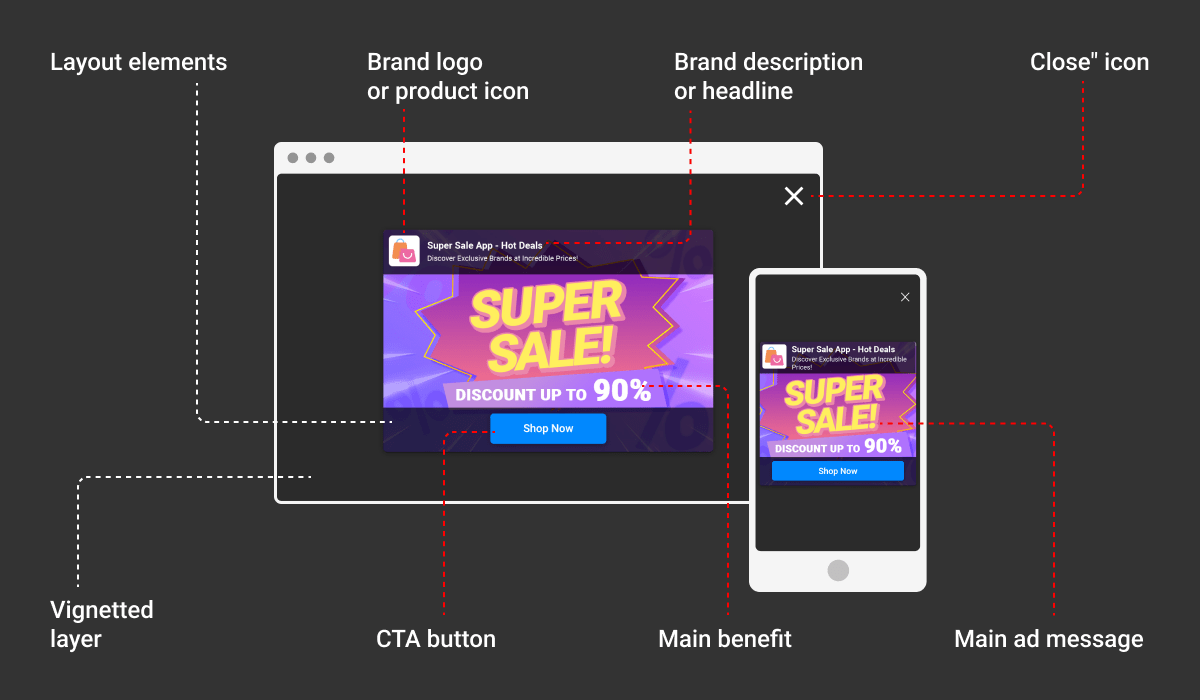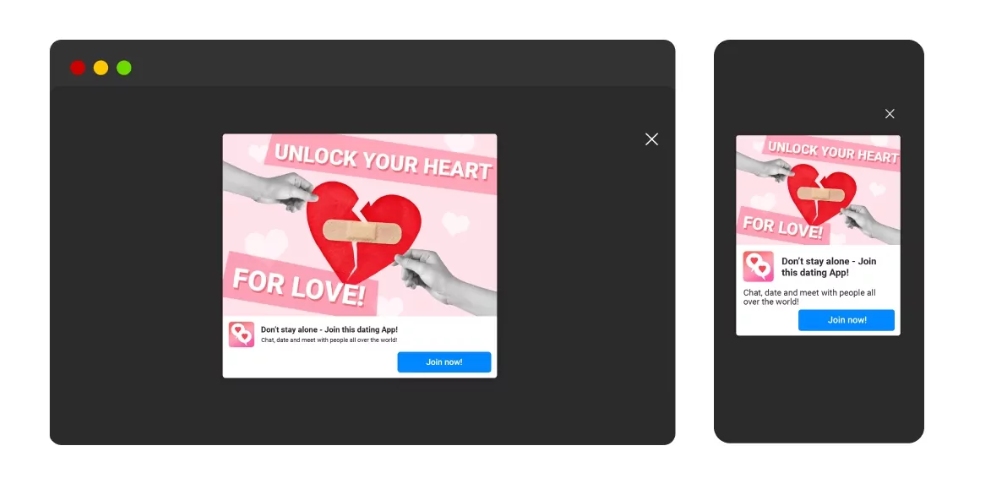Interstitial ads are full-screen ads that pop up when users interact with an app or website. They are becoming more popular because of their effectiveness and interactivity. This article will dive into Interstitial ads and how to use them to promote your brand more effectively.
What is an interstitial ad?
It is an advertising format that covers the user’s whole screen on a browser web page. They fully immerse users into the ad message, unlike Banners that occupy a smaller place or popups that appear randomly. For example, the ad might appear while a user is navigating through a website.

What is the size of Interstitial ads?
Some of the most-used sizes of Interstitial ads are 320×480 or 480×320 for smartphones and 1024×768 or 768×1024 for tablets/PCs.
- 320×480 (portrait) or 480×320 (landscape) for phones.
- 1024×768 (landscape) or 768×1024 for tablets.
- 600×400 (landscape, desktop ) and 300×500 (portrait, mobile).
The above sizes mean your Interstitial ads will display perfectly on most mobile devices and PCs or tablets.

How does interstitial advertising work?
The first step is the user landing on a website. Once they open the page, a request is automatically sent to the publisher’s ad network (e.g., Adsterra) to send an Interstitial ad.
The ad network already has a collection of Interstitials from different advertisers. It matches the offer with traffic, ensuring ad relevance. When an offer is chosen, it is displayed on a publisher’s website. Usually, a website visitor will see a full-screen ad with the main message and a vignetted background. Interstitial ads come in various ways, including a static full-screen banner or a smaller widget on a vignetted background. Readers may encounter such ads right after they open a website or while jumping between pages.
Of course, bidding takes place on the ad network. The network then sends the interstitial from the highest-bidding advertiser to the publisher’s website. However, advertisers can benefit from second-price auction (Smart CPM), as well. It’s a bidding strategy allowing for placing a maximum bid but paying only a bit higher than the second highest bidder. It’s a profitable strategy for advertisers willing to distribute budgets and increase ROI.
Why should advertisers use Interstitial ads?
The interstitial ad format offers many advantages for advertisers, including:
1. Engaging
This ad format is more engaging than other formats because it takes up the user’s whole display. It provides an interactive photo or video experience, and readers are more likely to respond to interstitial ads than other formats.
2. Multi-platform compatibility
The interstitial marketing works with all kinds of desktop and mobile devices. You can find it on desktops, Android smartphones and tablets, iPhones, and web browsers. This multi-platform compatibility allows advertisers to reach as many viewers as possible.
3. Higher click-through rates (CTRs)
Interstitial ads have higher click-through rates on average than other ad formats, providing more opportunities for advertisers to get conversions. Below is a case study of an iGaming platform that uses Interstitial ads to get hundreds of thousands of impressions and boost its revenue.
How much do interstitial ads pay?
Advertisers and publishers often resort to Interstitials. But does it actually pay well if you’re a publisher or blogger? Yes, it does. According to an Adnimation study, the average eCPM from Interstitials is 40x that of traditional Banner ads. According to the same study, Interstitials earned publishers an average of $7 to $62 per mille.
However, note that there’s no specific amount a publisher can make from interstitial screen ads. It depends on many factors, including the target audience, content niche, and advertising network. For example, ads from the U.S., U.K., Canada, and other economically developed and emerging countries (e.g., Brazil and Saudi Arabia) return higher payouts.
Some content niches also tend to perform more than others. For instance, Adsterra publishers profit from iGaming, E-commerce, Utility, and Dating offers promoted via Interstitials.
Adsterra increases publishers’ earning potential by providing access to a network of lucrative interstitial ads. Our platform connects publishers to over 15,000 advertisers, so there’s no shortage of ad inventory for a website.
Best practices of interstitial ads
- Design or upload multiple creatives for a test. You will get more traffic and more information about which of your offers and messages work best. Eventually, you’ll be able to remove low-performing creatives and focus on CTR-boosting ones. With Adsterra, it’s possible to upload up to 15 creatives, choosing between 10 main Interstitial templates.
- Offer discounts and freebies to customers. They’re more effective at grabbing customer attention than providing bland information. You can time your discounts to convince customers not to miss out on something valuable.
- Thoroughly select images and visuals. It’s great when your main visual delivers a clear message, not being just a background pattern or stock photo. Highlight the main value like in the example below.

- Ensure you provide a great call to action. No matter how catchy your ad is, some people need a little nudge to take action. So use active verbs and offer value: “shop now,” “get a bonus,” “become a VIP,” etc.
What is the best frequency for capping interstitial ads?
Interstitial ads are good but too many ads can disrupt users’ experience and make them hate your brand as well as the website they navigate. Advertisers must ensure their ads are displayed at healthy intervals.
- From the advertiser’s side, the best ad frequency is 1 per 24 hours, but it’s possible to increase it to 1 per 12 hours Setting up ad frequency is better while optimizing your marketing campaign, so as to say, when you have collected enough data about traffic behavior.

- From the publisher’s side (if allowed by an ad network), it’s better to cap interstitial ads at one per hour for each unique user. This timing ensures that users don’t repeatedly see the same ads.
Interstitial ads can yield great results if you place them well. Adsterra’s Interstitials don’t require any fixed space on your website because they cover the whole screen. Users are likelier to interact with the ad because of full-screen coverage and more so when you find relevant ads from our network.
If you want to reach relevant audiences and convert as many users into leads and customers, read through this guide to setting up an Interstitial campaign with Adsterra.
Things to avoid when launching Interstitials campaigns
Here are other tips advertisers should note about placing the Interstitial ad format:
- Don’t use too much text. Focus on the visual elements over text because they play a bigger role in getting conversions.
- Abstain from misleading ads that can get users angry and lead to potential legal consequences. You can be creative and catchy but stay credible.
- Shun inconsistent elements. Your Interstitials must match the design and content of your landing page.
Conclusion
Above all tips for advertisers, they should choose a reliable ad network connecting them with high-quality traffic from reliable publishers. Adsterra connects brands and media buyers with 35,000+ highly-rated publishers sending Interstitial traffic from 248 geos.
Publishers who want to monetize websites, will only need to register and get a Social Bar ad code, which encompasses all innovative ad types, including Interstitials.
FAQ
The interstitial ad format is engaging and more likely to elicit a response than other formats. It’s compatible with all kinds of desktop and mobile devices, which gives advertisers a higher chance of getting conversions. Advertisers are more likely to get good results from Interstitials than other types of ads.
PC or mobile Interstitial ads are very effective because they’re hard to miss. When you display Interstitial ads, they always capture the viewer’s attention and deliver your message. An Interstitial ad is highly engaging, especially when using creative graphics, which leads to higher conversion rates.
The interstitial format covers the entire screen with the advertisement and a darkened background. A user literally faces the ad they cannot overlook. A popup ad takes just a segment of the screen, blocking a user’s current activity on the page.
The defining feature of the interstitial ad format is that it covers the user’s entire display. Other notable features include having a close button, using rich media and graphics, and appearing after specific user actions instead of randomly.
Interstitial ads are full-screen ads that cover almost all the interface of their host app or website to get the viewer’s attention. An Interstitial ad is usually displayed at optimal transition points, e.g., when a user pauses a game or clicks a link to another web page.
An Interstitial ad placement or ad placement in general is a script or code placed on a publisher’s website. Advertisers then can unlink the poor-performing ad placements (those that return no clicks or conversions) or increase bids for the best-performing ones.
On a publisher’s website ads cover the entire page. They either appear once a user lands on a page, or can be displayed a specific user action: a click, navigation between pages, etc.
It is a full-page ad shown above the main web page’s content or between transitions points in a mobile app, e.g., after clicking a link, video pre-roll or post-roll, or game-level load. An Interstitial ad often produces better results than other types of ads.
